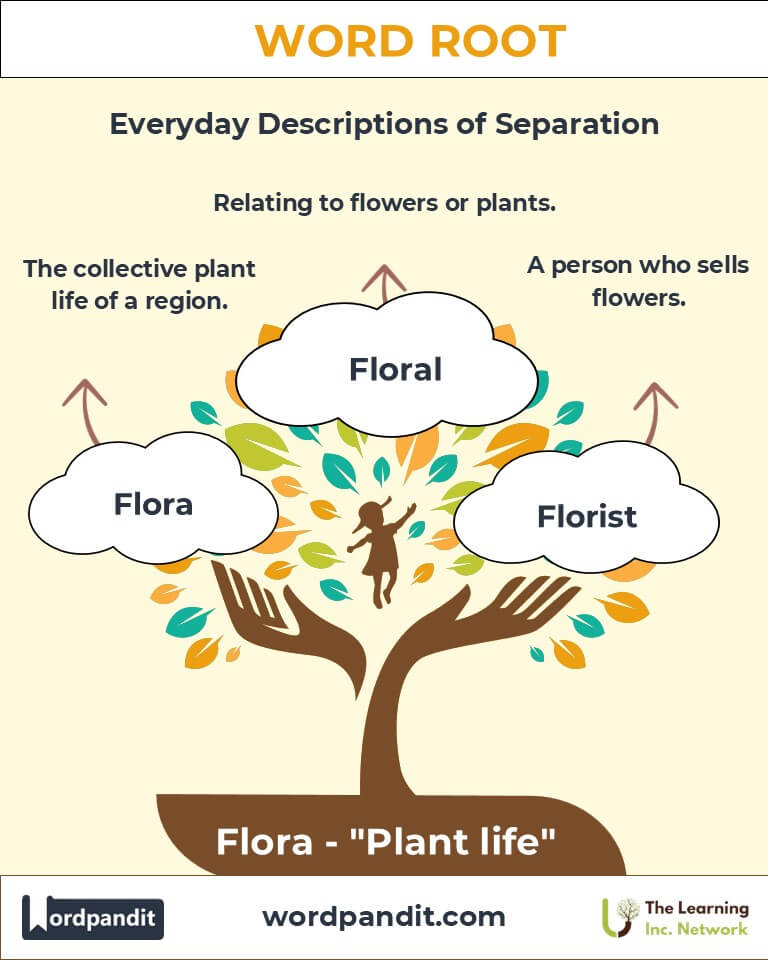Flora: The Root of Nature's Bounty in Language and Science
Unveil the charm of the word root "Flora," derived from Latin, meaning "plant life" or "flowers." From terms like "florist" to scientific concepts such as "flora and fauna," this root beautifully represents the diversity and vibrancy of the natural world in language, culture, and science.

Table of Contents
- Introduction: The Essence of Flora
- Etymology and Historical Journey
- Mnemonic: Unlocking the Power of Flora
- Common Flora-Related Terms
- Flora Through Time
- Flora in Specialized Fields
- Illustrative Story: Flora in Action
- Cultural Significance of the Flora Root
- The Flora Family Tree
- FAQs about the Flora Word Root
- Test Your Knowledge: Flora Mastery Quiz
- Conclusion: The Living Legacy of Flora
Introduction: The Essence of Flora
Imagine walking through a vibrant garden, surrounded by blooming flowers and lush greenery. The word root "Flora," pronounced "flo-ruh," brings this imagery to life, encapsulating the beauty and vitality of plant life. Derived from Latin, Flora signifies the collective plant life of a region, as well as the Roman goddess of flowers and spring.

Etymology and Historical Journey
The root Flora originates from the Latin flor, meaning "flower" or "bloom." In Roman mythology, Flora was the goddess of flowers, spring, and fertility. As Latin evolved, Flora became central to scientific contexts like botany and ecology, symbolizing plant life globally.
Mnemonic: Unlocking the Power of Flora
Picture a colorful bouquet bursting with flowers, representing the diversity of plant life.
Mnemonic Device: “Flora flourishes with flowers, spreading beauty and life.”
Common Flora-Related Terms
- Florist: A person who sells or arranges flowers. Example: "The florist crafted a stunning bouquet for the wedding."
- Floral: Relating to flowers. Example: "She wore a floral dress adorned with bright patterns."
- Florid: Excessively ornate or flowery, often in style. Example: "His florid writing style captivated readers."
- Flourish: To grow or develop vigorously. Example: "The garden flourished with the arrival of spring."
- Microflora: Microscopic plant life, especially in specific environments. Example: "Gut microflora is essential for digestion."
Flora Through Time
Flora and Fauna: This term, originating in the 18th century, contrasts plant life with animal life, emphasizing biodiversity.
Floral Design: From ancient garlands to modern bouquets, the use of flowers in art reflects Flora's enduring influence.
Flora in Specialized Fields
- Botany: "Floral Morphology" studies flower structures to understand evolution.
- Ecology: "Flora Surveys" catalog plant species, vital for conservation.
- Medicine: "Gut Flora" describes microorganisms crucial for health.
Illustrative Story: Flora in Action
In a bustling city, botanist Clara cataloged urban flora. Her findings inspired green spaces in urban planning, proving that Flora thrives even in unexpected places.
Cultural Significance of the Flora Root
Flora symbolizes renewal, beauty, and abundance in human culture, from ancient myths of springtime festivals to modern garden shows.

The Flora Family Tree
- Flor-: Bearing flowers, as in "Floriferous."
- Anth-: Greek for flower, as in "Anthology."
- Blossom: Refers to tree or bush flowers.
FAQs About the Flora Word Root
Q: What does Flora mean?
A: The root Flora means "plant life" or "flowers" and is derived from Latin. It describes vegetation collectively, such as the flora of a region, emphasizing the beauty and diversity of plants.
Q: Who was Flora in Roman mythology?
A: Flora was the Roman goddess of flowers, spring, and fertility. She symbolized renewal, growth, and abundance. Celebrations in her honor, like the Floralia festival, marked the blooming season and agricultural prosperity.
Q: What is the significance of "Flora and Fauna"?
A: "Flora and Fauna" refers to the plant and animal life of a specific region, emphasizing biodiversity. This term is widely used in ecological and environmental studies to highlight the interdependence of plants and animals in ecosystems.
Q: What is gut flora?
A: Gut flora, also known as gut microbiota, is the community of microorganisms that live in the digestive system. These microbes play an essential role in digestion, immunity, and overall health.
Q: How does the term Flora relate to science?
A: In science, Flora refers to plant life studied in botany and ecology. It is also used in medicine to describe microbial communities like gut flora or skin flora, reflecting the interconnectedness of life and health.
Test Your Knowledge: Flora Mastery Quiz
1. What does the root Flora signify?
2. Who is Flora in Roman mythology?
3. What is gut flora?
4. Which term refers to a person who sells flowers?
5. What does "flourish" mean?
Conclusion: The Living Legacy of Flora
The root Flora symbolizes the vibrant tapestry of plant life, enriching language, science, and culture. From ancient myths to modern ecology, it reminds us of nature’s beauty and resilience.












